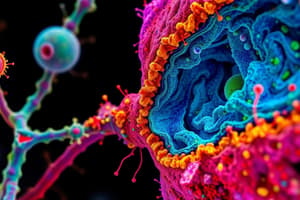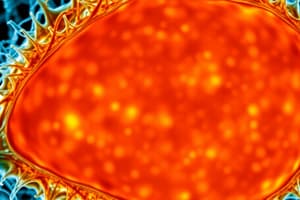Podcast
Questions and Answers
Which part would you adjust to make the image brighter?
Which part would you adjust to make the image brighter?
- Mirror (correct)
- Focus knob
- Eyepiece
- Objective lens
Which part would you adjust to make the image clearer?
Which part would you adjust to make the image clearer?
- Objective lens
- Focus knob (correct)
- Eyepiece
- Mirror
What is it made of?
What is it made of?
Cells
Were all of the samples made of cells?
Were all of the samples made of cells?
How were the cells of the samples different?
How were the cells of the samples different?
How were the cells of the samples similar?
How were the cells of the samples similar?
Which is the best drawing of onion cells?
Which is the best drawing of onion cells?
Why do you think it’s the best?
Why do you think it’s the best?
What is wrong with the other three drawings?
What is wrong with the other three drawings?
Which is the best drawing of animal cells?
Which is the best drawing of animal cells?
Why do you think it’s the best?
Why do you think it’s the best?
What is wrong with the other three drawings?
What is wrong with the other three drawings?
Which is the best drawing of bacteria cells?
Which is the best drawing of bacteria cells?
Why do you think it’s the best?
Why do you think it’s the best?
What is wrong with the other three drawings?
What is wrong with the other three drawings?
Flashcards are hidden until you start studying
Study Notes
Using a Light Microscope
- To adjust the brightness use the mirror
- To adjust the clarity of the image use the focus knob
- Objective lenses are used to magnify the samples
- To use a light microscope:
- Turn the turret to the lowest power objective lens
- Place the slide on the stage and secure with the stage clips
- Carefully turn the focus knob to move the objective lens closer to the slide, stopping before they touch
- Look through the eyepiece
- Turn the focus knob until the image is clear
- Adjust the mirror to reflect more light if necessary
- Turn the turret to the medium power objective lens and refocus
- When finished, move the objective lens away from the stage using the focus knob and remove the slide from the stage
Cell Drawings
- Onion cells
- D is the best drawing of onion cells as it shows the correct structure
- A shows a partially correct cell but misses the cell wall
- C is partially incorrect as it has no cell wall, but the cell membrane is visible
- B is incorrect as is shows no cell wall and the nucleus is incorrect
- Animal Cells
- A is the best drawing of animal cells as it shows the correct structure
- C is partially correct, with a visible nucleus
- B is partially incorrect, with the nucleus being too large
- D is incorrect as it shows the nucleus too large and there is no cell membrane
- Bacteria Cells
- D is the best drawing of bacterial cells as it shows the correct structure: a single cell without a nucleus, and the correct shape
- C is partially correct as it shows a round shape, but it includes a nucleus
- B is partially correct as it shows a long shape, but it includes a nucleus
- A is incorrect, as it has a nucleus and a cell membrane, and it is not the correct shape
Studying That Suits You
Use AI to generate personalized quizzes and flashcards to suit your learning preferences.




